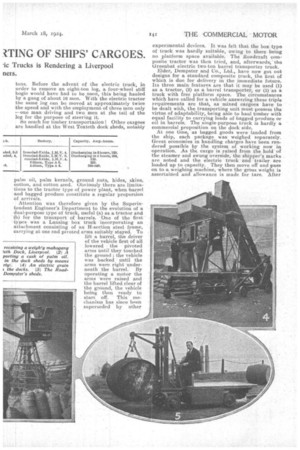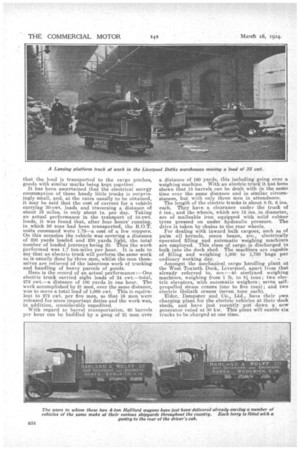RAPID HANDLING AND TR/ ITING OF SHIPS' CARGOES.
Page 16

Page 17

Page 18

If you've noticed an error in this article please click here to report it so we can fix it.
MUCH useful pioneering work in the utilization • of electric trucks for dealing with the transport of thousands of tans of-ships'.cargoes has been .undertaken by the well-known firm of Liverpool steamship owners, Elder, Dempster and Co., Ltd., who, over a period of many years, have been conducting experiments, first with one type of truck, then with another, to evolve .a model particularly Buited to their needs.
,Frequently, criticism is made . of the out-of-date system of handling quayside traffic at Liverpool, and, although there is now less cause for complaint, the fact remains that the work. of loading and discharging vessels in or about the dock estate is almost entirely undertaken by manual labour. At some of the northern docks the White Star, Cunard, and other companies 'employ the self-propelled truck, as also does the Liverpool Stevedoring Co., whilst, more recently, the Liverpool meat importing firms entered into an arrangement whereby, instead of eareases of frozen and chilled meat being conveyed from the ship's side to waiting motor lorries and to railway vans ,by the slow ,and laborious .method of handhauled trucks, the work is now done more cheaply, more expeditiousIy, and . with less effort, with
mechanical plant. . At the inward berths of Elder, Dempster and Co., Ltd., at Toxteth Dock, Liverpool, the introduction of mechanical appliances has practically revolutionized the handling of such heavy and cunmersome articles as barrels of palm oil, logs of mahogany, etc., which at one time involved the employment of a great number of men. With electric cranes, trucks and tractors, manual labour has been reduced to a, The fleet belonging to Elder, Dempster's, and consisting of trucks and tractors, comprises, about 10 units, as follow :
F-or the transportation of goods in and about the dock sheds, electrically operated vehicles may be divided into two classes :—(1) The truck which carries its own load, and (2) the tractor which hauls one or more trailers carrying the load. The first application of an electric tractor at the West Toxteth Dock was in 1916, when a Walker electric mule, with a haulage capacity of from eight to ten tons, was put into service. It was intended to haul mahogany logs from the ship's side to the stowing pitch, but, owing, at the time, to the embargo on the importation of timber, the mule was subsequently employed to haul mobile 5-cwt.. electric cranes (of which there are 30 in service) from station to station. The Walker tractor is still in service, doing good work.
When the importation of African mahogany was resumed, other elec. tric tractors were put into commission. The huge logs of this timber weigh anything from one to nine tons, the average being three
tons. Before the advent of the electric truck, in order to remove an eight-ton log, a four-wheel stiff bogie would have had to be used, this being hauled by a gang of about Id men. With the electric tractor the same log can be moved at approximately twice
• the speed and with the employment of three men only —one man driving and two men at the tail of the Jog for the purpose of steering it. So much for timber transportation ! Other cargoes are handled at the West Toxteth dock sheds, notably palm oil, palm kernels, ground nuts hides, skins, cotton, and cotton seed. Obviously there are limitations to the tractor type of power plant, when barrel and bagged produce constitute a regular proportion of arrivals.
Attention was therefore given by the Superintendent Engineer's Department to the evolution of a dual-purpose type of truck, useful (a) as a tractor and • (b) for the transport of barrels. One of the first • types • was a Lansing box truck incorporating an attachment •consisting of an H-section steel frame, carrying at one end pivoted arms suitably stayed. To lift a barrel, the driver of the vehicle first of all lowered • the pivoted arms until they touched the ground ; the vehicle was backed until the arms were right underneath the barrel. By operating a motor the arms Were raised and the barrel lifted clear of the ground, the vehicle being then ready to. start off. This mechanism has since been superseded by other receiving a weighfy mahogany Feth Dock, Liverpool. (2) A porting a cask of palm oil. in the dock sheds by means rty). (4) An electric grain the docks. (5) The RoadDempster's sheds. experimental devices. It was felt that the box type of truck was hardly suitable, owing to there being no platform space available. The Roaderaft composite tractor was then tried, and, afterwards, the Oreenbat electric two-ton barrel transporter truck.
Elder, Dempster and Co., Ltd., have now got out designs for a standard composite truck, the first of which is due for delivery in the immediate future. Its three main features are that it may be used (1) as a tractor, (2) as a barrel transporter., or (3) as a truck with free platform space. The circumstances which have called for a vehicle answering these triple requirements are that, as mixed cargoes have to be dealt with, the transporting unit Must possess the virtue of adaptability, being able to haul timber with equal facility to carrying loads of bagged produce or oil in barrels. The single-purpose truck is hardly a commercial proposition on the dock side.
At one time, as bagged goods were landed from the ship, each package was weighed separately. Great economies in handling charges have been reu. dered possible by the system of working now in operation. As the cargo is raised from the hold of the steamer and swung overside, the shipper's marks are noted and the electric truck and trailer are loaded up to capacity. They then move off and pass on to a weighing machine, where the gross weight is ascertained and allowance is made for tare. After that the load is transported to the cargo pitches, goods with similar marks being kept together.
It has been ascertained that the electrical energy consumption of these handy little trucks is surprisingly small, and, at the rates usually to be obtained, it may be said that the cost of current for a vehicle carrying 30-cwt. loads and traversing a distance of about 16 miles, is only about 1s. per day. Taking an actual performance in the transport of 34-cwt. loads, it was found that, after four .hours' running, in which 50 tons had been transported, the B.O.T. units consumed were 1.75—a cost of a few coppers... On this occasion the vehicle was covering a distance of 230 yards loaded and 230 yards, light, the total number of loaded journeys being 30. Thus the work performed was 1.7 ton-miles per hour. It is safe to say that an electric trunk will perform the same work as is usually done by three men, whilst the men themselves are relieved of the laborious work of truckingand handling of heavy parcels of goods.
Here is the record of an actual performance :—One electric truck carried eight loads of 34 cwt.—total, 272 cwt.—a distance of 180 yards in one hour. The work accomplished by 21 men, over the same distance, was to move a total load of 1,088 cwt. This is equivalent to 272 cwt. per five men, so that 16 men were released for more important duties and the work was, in addition, considerably expedited.
With regard to barrel transportation, 60 barrels per hour can be hal-Idled by a gang of 21 men over a distance of 160 yards, this including going over a, weighing machine. With an electric truck it has been shown that 15 barrels can be dealt with in the same time over the same distance and in similar circumstances, but with only three men in attendance. The length of the electric trucks is about 8 ft. 6 ins. each. They have a clearance under the truck of 5 ins., and the wheels, which arc 12 ins, in diameter, are of malleable iron equipped with solid rubber tyres pressed on under hydraulic pressure. The drive is taken by chains to the rear wheels.
For dealing with inward bulk cargoes, such as of palm oil kernels, cocoa beans, etc electrically • 2 operated filling and automatic weighing machines
are employed. This class of cargo is discharged in bulk into the dock shed. The machines are capable of filling and weighing 1,500 to 1,700 bags per ordinary working day.
Amongst the mechanical cargo handling plant at the West Texteth Dock, Liverpool, apart from that already referred to, are steelyard weighing niachines, weighing from 1 lb. to 81 tons ; two electric elevators, with automatic weighers ; seven selfpropelled steam cranes (one to five tons); and two electric Goliath cranes (seven tons each).
Elder, Dempsiter and Co., Ltd., have their own charging plant for the electric vehicles at their dock sheds, and have just recently pat down a new generator rated at 30 kw. This plant will enable six trucks to be charged at one time.




























